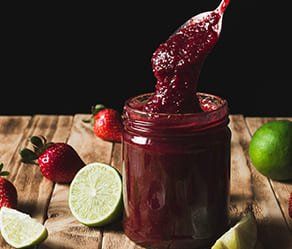Types of jams: what do you know about them?
Alimentos SAS • Feb 02, 2022
Since the beginning of humankind, food preservation – and on this occasion the different types of jams – has been known to all cultures from the Far East to America (North and South). It contributed to the settlement of humans since they could keep meat, vegetables, and fruit for later times.
In the beginning, humans preserved food by smoking, freezing, drying it. Later, with the arrival of sugar cane from the Far East to Europe and then to America, the preservation of fruit with the aid of sugar became very popular in the whole world. Although English men and women were known for centuries for being very skillful in this science (National Center for Home Food Preservation, 2002).
And we call it science because for obtaining good results, humans had to observe, experiment, repeat the process and then draw conclusions as with any other science (Britannica, n.d.). Nowadays, food preservation and the production of different types of jams have become a very prosperous industry, especially in the countries producing tropical fruits.
Different types of jams
Before sugar cane arrived in Europe, Greeks, and Romans used honey to preserve their fruits. Some centuries later, sugar cane and sugar itself came to Europe from India via seafarers. And with the entrance of sugar, people discovered a very useful way to preserve fruit, in many cases only produced during some seasons.
Under the category of types of jams, we can enumerate different types of fruit preserves. Let us look at the differences between some of them (Jam Making, n.d.).
1. Chutney
Chutney is a spicy mixture of vegetables and fruit preserves coming from India. For this preserve, they use not only sugar but also vinegar.
2. Conserves
Conserves usually mix different fruits with raisins, nuts, and citrus fruits. Typically, conserves can be eaten with bread or fill different pie types and types of pastry.
3. Compote or purees
A compote is a thick syrup with pieces of fruit or vegetables, while purees are a thick sauce made by crushing fruit and meat or potatoes. Compotes and purees are often included, for example, in babies’ diets.
4. Jam
As told before, jam is the generic name given to different fruit preserves made with sugar. It is also very similar to jelly.
5. Marmalade
Marmalade is a very well-known type of jam. It is normally made with the peel and not the pulp of the fruit.
Pulp of the fruit
Besides these types of jams, we can also find the pulp of fruit as a kind of fruit preserve. The pulp of the fruit is the most basic way to process it. Furthermore, it contains not only juice but also fiber. That is why it is very popular, especially lately when we can enjoy natural fruit flavors from distant places (The Berry Man, n.d).
The fruit industry
The fruit industry is a growing field in Latin American and Caribbean countries. In the late eighties, fruit markets moved from banana, sugar, coffee, and cocoa to the non-traditional agricultural sub-sector of fruit, and many agricultural diversification projects were implemented (Comunica, 2001).
Many countries are now focused not only on the production but also on the processing and marketing of tropical fruit products, ranging from different
types of jams to pulp of the fruit. The fruit industry has become a way to use natural resources to improve the economy and thus life quality in developing countries.















